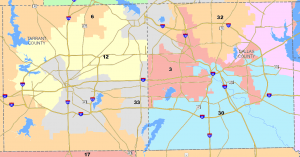Some fascinating news from Texas Redistricting.
Friday’s bill filing deadline in the Texas Legislature brought bills by State Rep. Drew Darby (R-San Angelo) – chair of the House redistricting committee – and State Sen. Kel Seliger (R-Amarillo) to make permanent the three interim maps drawn by the San Antonio court last year.
The identical bills (SB 1524 in the Senate and HB 3840 in the House) set out legislative findings that the interim maps “comply with all federal and state constitutional provisions or laws applicable to redistricting plans, including the federal Voting Rights Act” and that adoption of the maps on a permanent basis would “diminish the expense of further time and money by all parties in Texas’ ongoing redistricting litigation” and “avoid disruption of the upcoming election cycle.”
Ahead of Friday’s bill deadline, the chair of the House Democratic caucus, State Rep. Yvonne Davis of Dallas also filed placeholder bills (HB 3846 and HB 3847) to redraw the state house and congressional maps.
If I were in charge of the Texas Democratic Party and had the proxy of all of the plaintiffs and intervenors in the redistricting litigation, and the Republicans came to me with the offer of keeping the interim maps for the rest of the decade in return for not pursuing any further appeals to SCOTUS, I’d consider it to be a pretty tempting offer. If I felt confident that SCOTUS would leave the Voting Rights Act intact in the Shelby case, and in the Texas redistricting and voter ID cases, and anything else after that, I’d thank them and decline, on the grounds that I would expect further remediation of the existing maps from the San Antonio court. Given that it’s at best a coin flip that Section 5 stays in place after SCOTUS rules, I’d stick out my hand and say “You’ve got a deal”. Given that the state intends to have the maps drawn by the Legislature in 2011 implemented in the event of Section 5’s demise, as a straight-up expected value proposition it’s hard to see a downside to this. That in turn makes me wonder who Darby and Seliger talked to before filing these bills. I figure the reaction in Greg Abbott’s office is something like “WTF are they doing over there?” I haven’t seen any news stories about this, so I’m just speculating, but it sure is intriguing.
As for Rep. Davis’ bills, there’s a link to the maps for them here. The Congressional map is especially interesting. It restores CD25 as a Travis County-anchored district, and restores Travis County to having only three districts in it (CDs 10 and 21 being the other two), while creating a new Latino district in Dallas (CD03), restoring CD27 to South Texas, and moving CD34 to Central Texas. CD33 moves to be entirely within Tarrant County, and remains a black/Hispanic district, probably at least as favorable to Rep. Marc Veasey as the current district is. Going by the population distribution (compare to the current map here), I would expect Dems to pick up CDs 03, 25, and 27, lose CD34, and I can’t tell what might happen in CD23. I haven’t taken a close look at the legislative map, but I will note that it makes HDs 105 and 107 in Dallas County a lot less white (compare current to proposed demographics), so you can draw your own conclusions. It’s a little hard to imagine a scenario under which these bills would be taken under consideration; my guess is that they’re creating a baseline for the San Antonio court to evaluate if Section 5 is left alone. I’m just guessing.
Anyway. Tomorrow is the deadline for both sides in the San Antonio case to submit their briefs outlining what they think should happen after SCOTUS rules one way or the other on the Voting Rights Act. That may tell us a lot about how confident each side is of their position.


Pingback: More time for redistricting advisories – Off the Kuff
Pingback: Texas blog roundup for the week of March 18 – Off the Kuff
Pingback: Abbott asks for the interim maps – Off the Kuff
Pingback: Advising the court on redistricting – Off the Kuff
Pingback: Still pondering Abbott’s redistricting motives – Off the Kuff
Pingback: Abbott predicts special session for redistricting – Off the Kuff